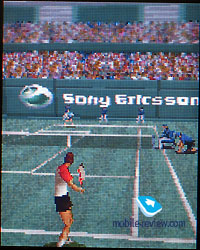Official
photos of Sony Ericsson K700
Standard kit:
- Phone
- Battery
- Charger
- Stereo headset
- Manual
Sony Ericsson made a quite revolution after presenting the model
T610
about a year ago, during this term the phone became bestseller
around the world. It is still very popular, that’s why the
manufacturer does not have enough power to satisfy the hunger.
With the year taken as interval Sony Ericsson presented new model
– K700, which is targeted for youth, it is supposed to become same
thing, as T610 was during its time. We’d like to point out that this
phone is not successor to T610/T630 series, unlike the obvious
function and feature similarity. From the marketing point of view
this model is targeted for different segment, the design for youth
can be taken as proof for this statement. The design however remains
strict and stylish. The technical specifications are actually
cut-off version of 3G phone - Z1010, the phone’s software speaks out
for itself. More than that, existing firmware versions contain
curious menu item – videocall, although in reality K700 has only one
camera inside. In future other models from K-series will be
released, they will differ with the functionality. But since K700 is
the first phone from this line-up it plays important role,
especially considering the fact that there are not any similar
products from other manufacturers. The only competitor in this
segment is Siemens CX65, but in reality it loses clearly comparing
to K700, in terms of price and functionality.
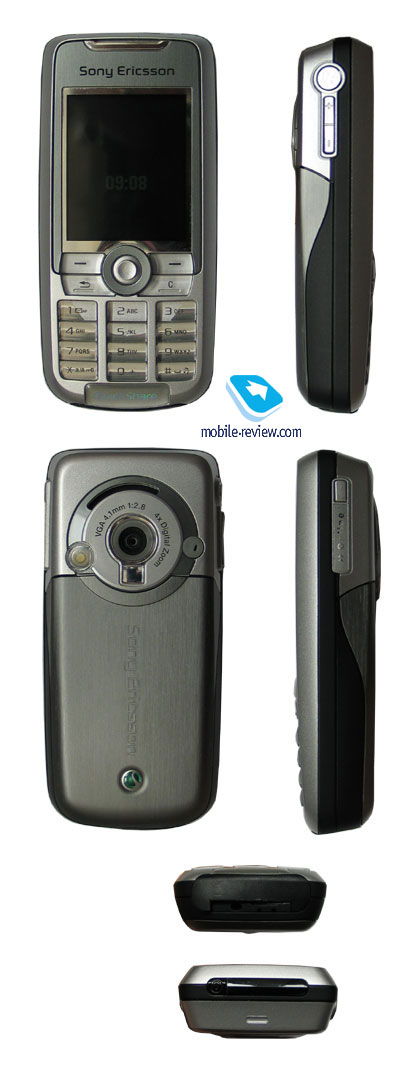
The phone’s design is strict, two color solutions will be
available - Optic Silver, Blue Tinted Silver. In both cases bigger
part of the case is made in one color, only different is edging. In
K700 designers decided to keep shape of other models, and introduced
new elements as well. What has remained as legacy – its size:
99x46.5x19.5 mm. If you compare this model with Ò610/Ò630 you will
notice that it’s 3mm lower and at the same time some mm wider. This
does not affect convenience in terms of using though, the phone fits
nicely into ones palm. The weight is 93 grams, this can be compared
with previous models.
The keyboard is made of semi-transparent plastic, partly MATOVIJ,
its color is white. The shape and key placement are similar to T630,
designers were trying to achieve this effect on purpose. The
keyboard’s backlight is white, symbols are clearly seen in all
conditions. The phone’s ergonomics deserves a lot of various awards,
it is very convenient and no problems are encountered. The key’s
size and convenience affects the overall impression from the phone,
it is very convenient.

Same thing can be said about the joystick, which is tight enough,
the button is rather big. The joystick reacts to the presses,
although accidental key press do not occur rapidly, this is a great
advantage. Comparing to T610 the joystick’s size increased, that’s
why a lot of people will find it easy to use.
A circle which is performed in another color is element of
appearance, it is formed around the keyboard, it is clearly seen in
darkness. This circle is rather symmetric to circle around the
camera, which is located on the back side of the phone. At first it
seems to be a simple solution, but in reality we get an attractive
design element.
The screen can be considered as the most interesting part of new
model. It is made on TFT-technology and can display up to 65000
colors. The screen has resolution of 176x220 pixels, which allows
displaying up to 7 text lines and up to 3 text lines reserved for
service needs. The screen’s quality is superb, the picture looks
lively and sharp. If you compare the screen with Sony Ericsson Z600,
T630 it is clear that K700’s is a lot better. This parameter is
actually better than all models from Sony Ericsson, and a lot better
than Nokia and Siemens phones (ST55/ST60 are similar, but they are
purely ODM models). It is worse than the displays of the new
shipments of v-series from Motorola (v300,
v500,
v600,
v80, v400), it is not so bright. On the other hand the screen is one
of the best on the market, it doesn’t have many competitors,
especially in the form-factor of an ordinary mobile phone.

The screen turns slightly pale when it hits direct sunlight, the
picture remains clear and visible even during spring sun, which is
very bright.

Joined volume control button is located on left side, just above
it a special key for camera is located. On the right side you can
see special internet soft-key. Let’s move on to the upper part of
handset. Power ON and OFF button is located on the top, IrDA is
hidden under smooth plastic. On the bottom part of the phone you can
see the interface connector, it is fully compatible with previous
models. For the first time the company decided to introduce rubber
cork for this port, it is attached to the case really solid. Those
who experience inconvenience during its presence will be forced to
cut it off. This will be required if you will decide to use desktop
charger as well. Of course you can lean the cork on the right angle
each time you will need to perform similar action, but removing it
completely will be a better thing to do. On the whole the cover fits
solid to the case, even after few weeks of using it remains
still.
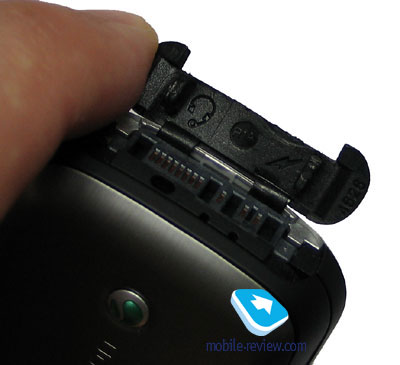

VGA-camera is located on the back side of the phone, a small
mirror is located right next to it, on the left you can notice small
flashlight. The company does not call this flashlight a flash, this
device is used for backlight during process of taking pictures in
complete darkness. With its help you can take pictures of objects
located on close distance, about 30 centimeters.
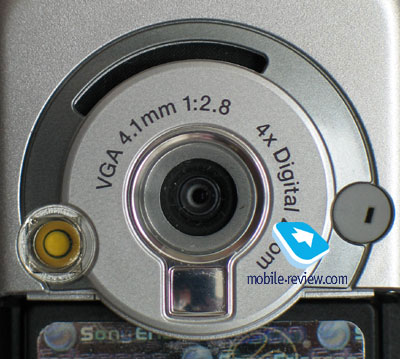
The hole which can be seen above the lens was supposed to be used
for the camera’s shutter. But just few moments before the official
launch this feature was removed, because it affected loudspeaker
badly, volume was decreasing.
The back cover is covering battery section. This model use
Lithium Polymer battery BST-30, it is installed in such models as
Sony Ericsson T230, Z200. Models T610/T630 use battery BST-25, which
has slightly more capacity. In this case the battery has 670mAh
capacity. The manufacturer claims that it can work up to 7 hours
during talking and up to 300 hours in the stand by mode.
We decided to test similar ways of using the phone with K700 and
T630. With 45 minutes of talks and up to one hour of Bluetooth
usage, 20 minutes spent for other functions (games, calendar,
backlight was always turned on) both phones managed to work for
about two days. K700 worked for about 10-15 percent less than T630.
The explanation is hidden behind different type of batteries, one of
them (K700’s) is not as big as the other one. Seems that the company
decided to decrease model’s weight and point out its youth status,
differ it from the business models.
More interesting thing to do was testing the phone with usage of
Radio, loudspeaker, short usage of IrDA, Bluetooth for file
exchange. With 3-4 hours of listening to radio via headphones, up to
30 minutes spent for talks and about 25 minutes of other function
usage the phone worked for about two days. Basically we used its
features for 100%, there was no energy saving around. With not so
much time for work this will be average time for all users. It takes
around 1.5 hours for the phone to fully charge up.
Considering the screen’s quality, presence of loudspeaker we can
come to the conclusion that the phone’s working time is typical
enough for similar models. On the whole the phone looks very solid
by this parameter.
SIM-card holder is standard, it does not have any lockers,
passive construction is used. Take a look at the area which is
marked with red arrow, in the upcoming T-series model it will be
used for expansion card slot (MemoryStick Duo).

Before going on to the interface description, I would like to say
some words about stereo headphone headset. Unfortunately
manufacturers decided not to make separate port for the headphones,
the plug itself is rather big, with time lockers can fall off. This
situation was typical for headsets for other models which had same
construction. The lack of separate port for headphones should be
considered as disadvantage, especially since the cork is present, it
should be leaned off every time you use the headphones.

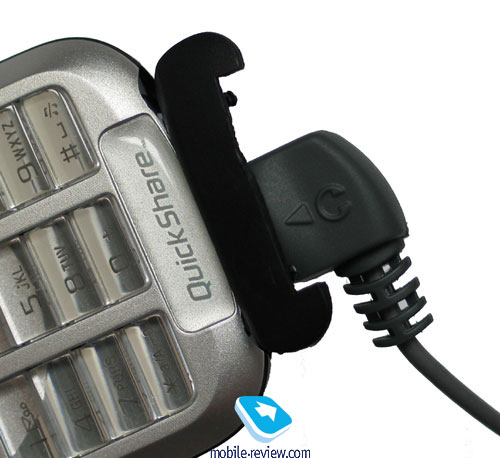
The headset is convenient, it has special button for voice
dialing, phone call decline.
Menu
Changes in the interface are noticed right after the phone is
turned on for the first time. You will be introduced to your
personal helper, who will help you setting up the phone. In several
slides you will find out about main soft-keys, will be offered to
enter date, time, copy entries from SIM-card into the phone’s
memory. In the very beginning you are offered to choose menu
language, on other phones this feature is not present right during
the start. Pretty simple function, but the first time it got
introduced is K700. Basically this helper can make the things better
for newbie for whom K700 is first phone from Sony Ericsson. In
future it can be left turned on every time the phone will be turned
on, it is all up to you weather you need this function or no.

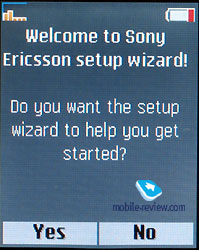

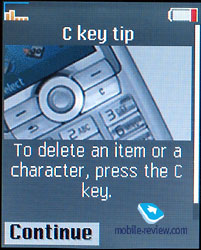

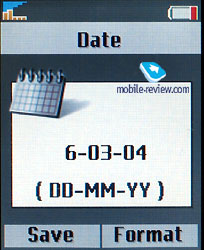
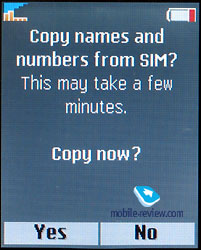

Allright, let’s imagine that the phone is turned on, you see
usual T610 design, signatures for soft-keys. Let’s try to lean the
joystick in one of the directions and see what will happen. The
phone signalizes the fact that there is no shortcut for the earlier
made action, and you are offered to bind one. For five minutes most
usable functions will be assigned to joystick’s sides, and you will
test how they work. Curious fact that during shortcut setup menu is
presented in substrate view of shortcut’s icon.


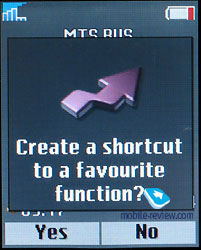
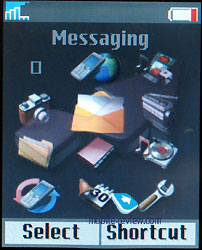
The main menu is presented by four rows of icons, three in each
row. Unlike the previous versions icons look prettier, they are
better drawn. Most likely this is due to the higher screen’s
resolution. In main menu manufacturers decided to review the
animation, while moving from one item to other a circle which will
highlight the current item will appear. Animation is extremely
pleasant and is not annoying at all, even if you use the phone for
long term. Surfing through the menu speed deserves separate praise,
no slow downs, everything works surprisingly fast. The user can use
shortcut number navigation in case he wants to, this way road to the
required menu item will take only 1-2-3 seconds.
The input convenience remained on the same level, by pressing the
# key you will bring up available language list, and be able to
switch between them while text inputting.
Video
clip which demonstrates menu surfing (AVI, 8Mb)
That’s about it what can be said about interface’s changes. The
manufacturer decided to take care of additional horizontal theme
bookmarks. This means that now when you are in the call list menu,
which is called by pressing the Call button, you will see not only
the last dialed numbers but gain the ability to switch between
bookmarks with last missed/received calls (horizontal joystick
presses). In the phone’s menu such navigation is used in all
possible places, it strongly simplifies usage of phone, menu’s
ergonomics in this model is extremely high. I’d like to point out
that similar horizontal panels present in the phone book, settings
menu and several other menu items as well.
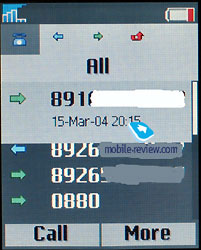

Camera. The phone has VGA-camera on board, it
has 4x digital zoom function. Manufacturer points out the fact that
the phone’s design is dual, on one hand we have a typical mobile
phone and on the other (back side) a sort of digital camera.
Considering this we come to the conclusion that the pictures can be
taken with one hand, instead of two. Volume regulation button plays
the role of zoom, and the separate button is used for shutter.
Meanwhile the picture is displayed on the screen that plays the role
of viewfinder.
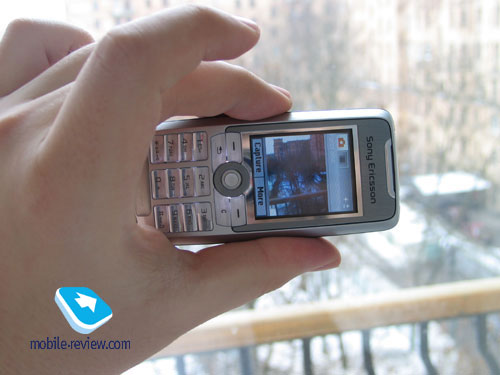
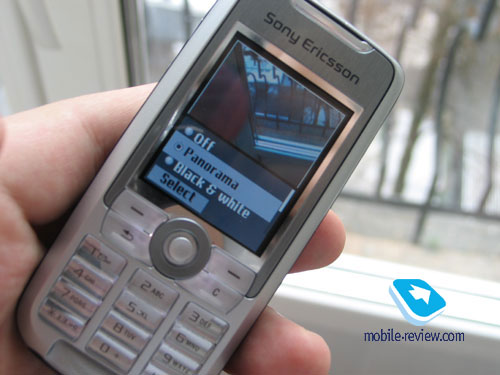
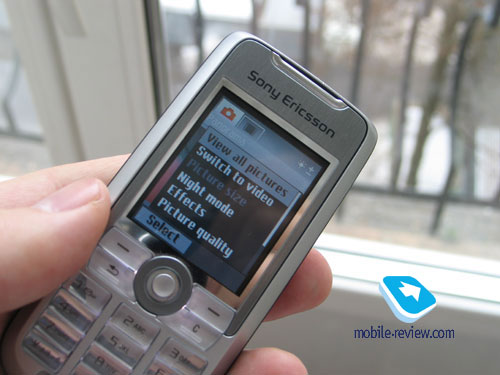
Received pictures are automatically oriented in the required
direction, this leaves you from mock with its rotation later. On the
hole those, who is not used to hold the phone in such unusual way
can take the pictures in old-school way. The interface is drawn
vertically, which means that it is actually supposed to be used with
standard shooting mode.
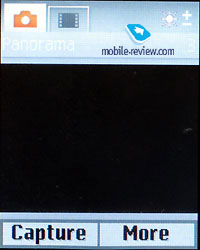
Presence of bookmarks can be considered as advantage. They allow
quickly moving from one picture taking mode to another, as well as
video capture. The phone can record video clips in 3GP format, sound
will be recorded as well. The clips themselves look nicely on the
screen, most likely due to the screen’s superb quality. They look
even better than those who were recorded on Nokia 6230. Upload of
video clip from Sony Ericsson K700 to Nokia 6230 showed that Nokia
has worse screen, the clip was displayed worse, picture’s quality
was not as good as expected. On the other hand such video clip
quality can never be recalled as being good you can’t expect much
from them. K700’s peculiarity is sensitive microphone, recorded
sound’s volume while being played on PC is extremely loud. Video
clip’s recording time for our firmware version was limited by 30
seconds, in future versions this limitation may be removed, in that
case recording time will be limited only with the amount of
available free memory.
Video
1 (3GP, 48Kb)
Video
2 (3GP, 112Kb)
Video
3 (3GP, 112Kb)
Video
4 (3GP, 80Kb)
Video
5 (3GP, 64Kb)
Video
6 (3GP, 168Kb)
Flashlight which is presented in this model is interesting when
taking pictures on the distance of about 30 centimeters. In other
conditions this feature is useless, although it can be used as
flashlight.
The phone supports three picture resolutions, best of them is
VGA, there are also few quality modes, picture compression (standard
JPEG files). The phone has various effects and the ability to use
night mode. From various effects such unique feature as panoramic
shooting should be mentioned. In this mode you are doing first shot
and you will see its image displayed on the screen, meanwhile part
of the screen is white, it shows part of the taken picture. You are
combining white part of the slide with the thing you see in the
viewfinder and take the shot again, and again. As a result you get
complex image, panorama. You can see a sample of such pictures here,
its resolution is 1648x438 pixels. You don’t have to put any special
effort in order to get this sort of picture, for example the sample
was made during several seconds. And here is what can turn out in
case you do not follow the rules of overlay one image over another.
The picture turns into phantasmagoria. From artistic point of view
such pictures contain certain amount of sense; I am sure that this
process will be popular among a lot of young K700 users.

Received pictures can be used as wallpapers, it can be easily
sent to any device with the help of IrDA or Bluetooth. They can be
sent via MMS as well, either with the help of built-in e-mail
client.
Picture viewing process can be made from Album, they are
displayed as thumbnails, everything is pretty common.
Picture example,
another one,
as well as this one,
and the last one.
Radio. The phone has a built-in FM tuner, it is
the first phone with such function from Sony Ericsson. The phone’s
memory can store up to 20 radio stations, the stereo headset that is
shipped in every package plays the role of antenna. In case you are
using auto-search the phone will find about 6-7 stations with the
strongest signal’s coverage (at least it did it in Moscow) and store
them in the memory. At the same time radio stations with weaker
signal, but pretty suitable for listening will be skipped. They can
be added into the list manually. This parameter is identical to
Nokia phones, in which same problems are noticed.

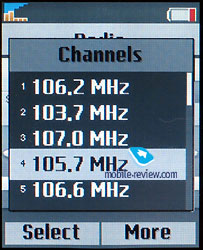
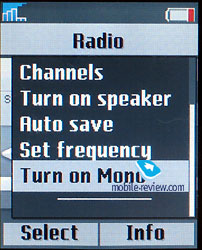
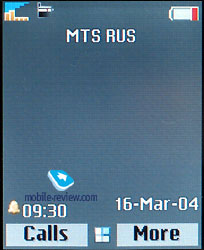
Signal’s playback quality is rather high, the headset allows to
set up almost any volume, maximal level is extremely loud, the music
will suppress everything. The user can switch the radio into the
loudspeaker mode, in this case people around will hear it as well.
The radio’s volume is pretty high.
Unfortunately all control is made from the phone’s keyboard.
Channel switch which are stored in the memory – joystick’s vertical
movement. You can regulate the volume with the help of side-buttons.
In case you want to turn off the radio and move on to other menu
item’s functions you will have to minimize it the way you are doing
it on your desktop pc. In order to have the ability of changing
channels again you will have to call Radio mode again. In minimized
condition appropriate icon will appear.
Brief impressions from the radio can be described as positive,
this phone’s parameter is interesting, more than that, it offers
quality realization. The radio is not worse than in Nokia’s products
and this speaks out for a lot of things, as well as the fact that
the radio works in stereo mode.
File manager, amount of memory. The manufacturer
decided to announce the fact loudly that the phone has 32 Mb of
memory on board, but in reality we face the fact that the user can
use about 42 Mb of free space, on which his data, files (pictures,
video clips, applications) can be stored. Remaining memory is
occupied with pre-installed applications, which you cannot delete.
Part of phone’s memory is used as phonebook, call list etc.
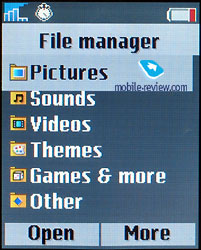
The phone also gained simple file manager, with its help you can
sort files into various folders, create directories in the phone’s
memory and store files in them. Using internal memory for file
storage is impossible, the phone declined storing files with unknown
extensions. But if you rename the file (its extension) it will be
easily stored in the phone’s memory. Meanwhile when we tried to view
it, it lead to error; however the phone did not freeze and continued
working. In future you will be able to send files via IrDA and
Bluetooth in near future. Basically we face the fact that the phone
can be used as file storage for very important files.
Presence of file manager makes the life significantly easier,
with its help you can sort out loads of pictures, prepare them for
transferring process to PC. The phone still has the same problems
like T610 and T630 had – pictures are taking up twice as much memory
as they do when they are already on your PC. Most likely this is due
to the peculiarities of file system’s organization. Curious fact
that when you are viewing properties for the picture, you will see
correct information about picture’s size, but if you look at the
free memory amount, it will be decreased twice as much after taking
the picture. Since there is a lot of free memory to use this problem
is not actual.
Player. The phone has built-in mp3 file player,
as well as 3GP. This function came from Sony Ericsson Z1010, which
had support of exchangeable memory cards, in that case this feature
had sense. Here the memory is enough for keeping 20 minutes of poor
mp3 file sound quality, there is no use of creating playlists. At
the same time player is actually a nice tool for listening to mp3
files, the phone can be used for file storage, you can store one or
two songs in very good quality. This is the only use for using the
player, it can not be used as alternative to mp3 player.

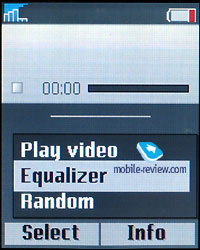
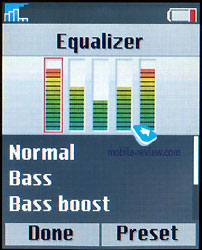

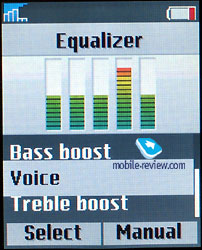
Equalizer setup is present among the other settings (Bass, Voice,
Tremble etc), as well as the ability of creating your own settings.
Depending on these settings the sound will actually change, this is
noticeable.
Phone book. Functional possibilities of the
phonebook remind ones for Sony Ericsson T610, but the interface was
redone. For example, one entry can be associated with several phone
numbers, e-mail address, other contact information. In settings you
can choose the required fields, as well as sorting by various fields
including name, surname, but the input field remains single. Such
sorting is important only while transferring data from PC, for
phone’s entries it’s actually useless. For separate names you can
setup custom ring tones and own picture, while the incoming call you
will hear the custom ring tone, as well as chosen image.
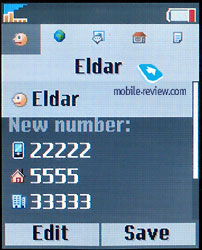
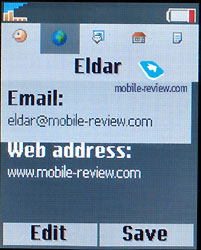
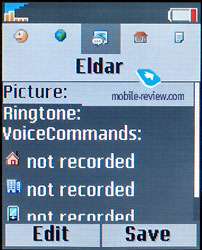
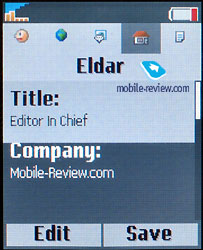
While information input you are free to scroll between bookmarks,
on the first one phone number entering and their sorting according
to types. Actually this organization reminds Outlook for some
reason, it is convenient. Ability to add voice dialing to separate
numbers stored under one name was introduced as well, there can be
up to 40 of them in total. If you remember, earlier on voice dialing
was supported only for 1 name, and you had to make additional voice
dialing bookmarks for other phones stored under the same contact.
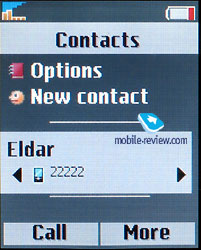

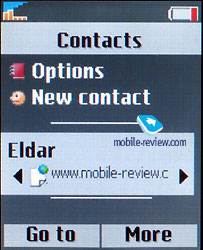
While viewing the phone book you can scroll the numbers by the
horizontal joystick’s keypress, as well as watching other
information. Of course the default number will be bind by you.
Traditionally the company believes that SIM-card and its memory
will be used only in emergency situations, and not for storing
information continuously. Viewing the entries on the SIM-card is
possible from the separate menu item, they are not displayed in the
common entry list.
Messages. All functions are basic for messages,
templates and ability to create your own ones are present. For
messages storing phone’s memory as well as SIM-card’s is used. Chat
function is supported, on the whole I can say that the features are
pretty common for any other phone. Appeared emoticons should be
mentioned as well, they are made on a new quality level, and support
youth part of the phone.

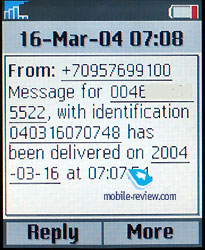
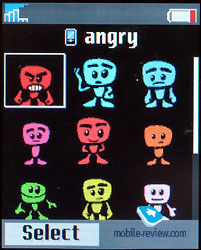
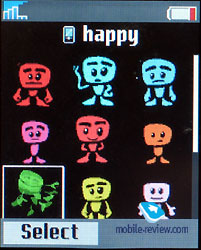

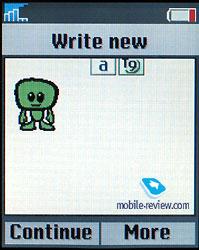
MMS realization deserves to be mentioned as well, you can
actually create clips, there are a lot of settings and it is not
hard to use them, a truly unique quality that other phones lack.
E-Mail client supports sending and receiving messages, all
possible encodings are supported.
In this menu Instant Messaging is present as well, sort of ICQ
analogue, this technology becomes popular really fast and by the
time K700 will be released it will be demanded by a number of users.
Call list. In common list you will see up to 30
entries with date and time assigned to each. Near each of them an
icon will explain to what type of call it refers (missed, received,
dialed). Besides this in common list additional icons are present,
they show if the phone number is present in the phone’s memory, or
SIM-card’s. The list of missed calls can be viewed separately, it
can store up to 10 entries. In the same menu item information about
cost and length of last, all calls can be viewed. Moving through the
separate lists can be made with the help of bookmarks, this actually
saves your time greatly.


Entertainment. This menu item contains access to
picture album, list of music files. Function MuiscDJ is interesting,
although it is rather niche and will not be in demand around most of
users. In this editor you can create your own ring tones and edit up
to 4 tracks.


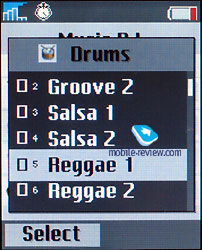
In case you are creative person you can use graphical editor, in
it you can draw simple pictures. Sometimes with its help time flies,
but in most cases this function is useless.
Organizer. In organizer menu a lot of functions
are stored at once, first of all – let’s review the calendar. There
are three types of event view, monthly, weekly and daily. In last
case you see the list of all things to do and reminders, in two
other modes you will notice the highlighted time with events or the
day. Fast transfer to the required year, day and month is present.
Everything is pretty simple and traditional, as well as schedule
entry. Basically you get the chance to choose one of the 6 icons
assigned to the action type, specify the place where it will occur,
length and setup reminder (beforehand or in the entered time). I was
unable find a way to setup reoccurrence rate, in my samples this
feature was not present at all. From the editing menu for separate
events you can choose another time and date, and that’s it.
Reminders work even if the phone is turned off, in case you turn on
this function in the settings menu. Pleasant peculiarity of this
model is that you can turn on/off automatic switch of profiles after
the event had occurred, as well as return to the earlier set profile
after the event is over. Basically we get analogue of Time Profile
function in Nokia’s phones.


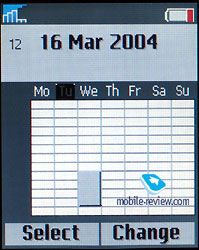
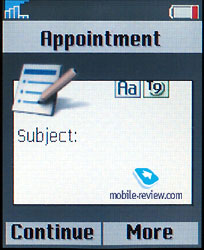

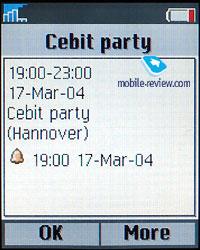
To do list of rather ascetic, only two modes of events, call or
reminder. On the other hand this is pretty enough, simplicity has
its own advantages as well.


The phone has fully-functional search, which is organized for
calendar, you just enter the words (or part of it) and after few
seconds see all events which suit for the searched words. Function
works very fast even if there are more than 100 entries, fast
teleportation to the event is supported as well.
The phone has normal support of sending files to different
devices (like always – IrDA, Bluetooth). You just choose the
required interval (day, week, or month) and send all entries. I’d
like to point out the fact that receiving device must support PIM
function in order to receive and display these data files correctly.
When we tried to send our own schedule to TV-set it was successful,
although it could not be displayed (via IrDA). Same thing can be
sent from your office or desktop PC without any additional software
for synchronization.
Notes. The phone supports recording short text notes, in common
list first word from each is displayed. This is not always
convenient since you have to enter every note with “marker word”.,
in order to understand what it is all about.

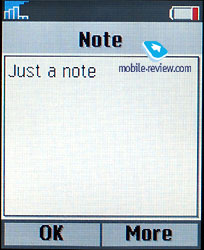
Alarm clocks. The phone has single as well as reoccurring alarm
clock, which can be setup by the defined days of week. The alarm
clocks will work even if the phone is turned off.

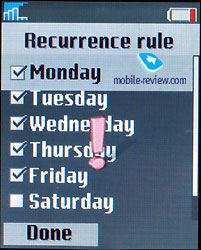
Countdown timer. Everything is pretty simple here, although same
thing can be said about the stop-watch, it supports intervals. The
phone has code storage, which was loved by many, working with
calculator became more convenient.
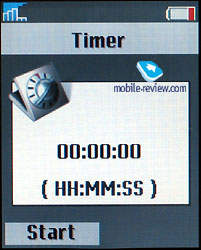
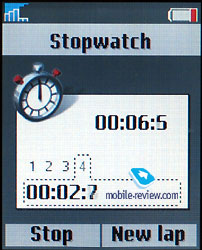
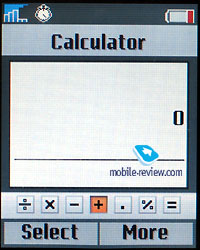
Connectivity. From here you can setup all
communication settings of the phone starting with WAP, GPRS and
ending with Bluetooth as well as synchronization. The standard usage
will not be mentioned, it is pretty obvious, everything works. The
stability of Bluetooth should be mentioned though, no problems were
encountered, synchronization with devices runs smoothly, all
profiles are supported.
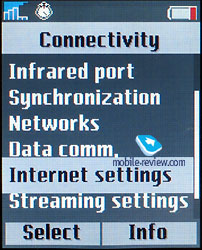
The very same menu allows setting up local and external
synchronization, everything is pretty common as well.
WAP. The browser was given separate menu item’s
sport, its version is 2.0 and it supports secured transfers, which
is important for electronic transactions. With the help of browser
you can download new wallpapers, themes, ring tones, everything is
available on the original web-site.
Settings. Basically all settings related to the
work with the phone are stored here, partly with the appearance of
screens. I will not describe this menu item, since everything is way
too common. The presence of updated themes should be mentioned
though, they actually differ the appearance nicely.
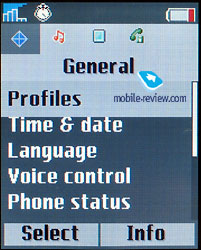
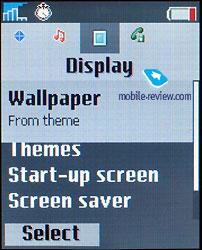
Java. The phone supports Java (MIDP 2.0), as
well as 3D-engine, which allows launching truly three-dimensional
games. I will say that they are rather interesting and are launched
rather fast. Subjective impression from usual games available for
T610 as well witness the fact that K700 works with Java applications
faster.
Another phone's exclusive feature is the possibility of enlarging
the screen for the games, that actually also expands the list of the
games to be played.
.jpeg)
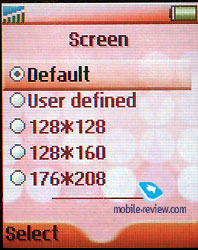
.jpeg)
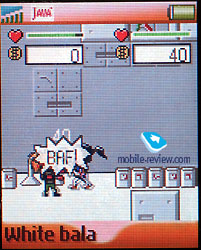
.jpeg)
.jpeg)

